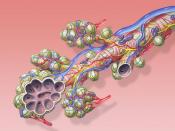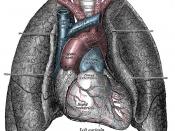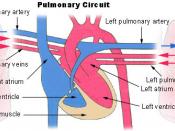The respiratory and circulatory systems are very important parts of the body. Together, they work in many different ways.
The heart is a hollow muscular organ. It?s the main part of the circulatory system. It is used to help pump blood into rest of the body. It is located behind the sternum, in-between the two lungs. The lungs are a pair of organs that are part of the respiratory system.
The right lung has three lobes and because the diaphragm is higher up on the right side to make room for the liver, is wider and shorter than the left lung. The left lung is thinner and longer than the right, because there is a notch for the heart to fit.
When blood flows from the left ventricle to the rest the body, except for the lungs, and back to the right atrium, is called systematic circulation. This system carries nutrients and oxygen to body tissues and to remove carbon dioxide and other wastes from the tissues.
All systematic arteries are branched from the aorta. Blood comes back to the heart through the systemic vein. All of the veins in the systemic system flow into either the superior or inferior vena cava. Then they empty into the right atrium.
When the right atrium is full with blood, the valve opens and the blood goes into the right ventricle. It pumps the blood through the pulmonary arteries an then into the lungs. The pulmonary artery splits. Some of the blood goes into the left lung, and some blood goes into the right lung.
The oxygen and carbon dioxide exchange takes place in the alveoli. Alveoli are little sacs at the end of the bronchial tubes. Each alveolus is served by tiny blood vessels called capillaries. Oxygen in the alveolus crosses the...


